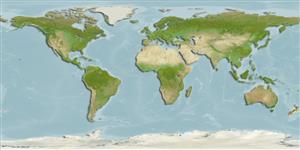>
Blenniiformes (Blennies) >
Tripterygiidae (Triplefin blennies) > Tripterygiinae
Etymology: Apopterygion: Greek, apo = outside + Greek, pterygion = diminutive of pteryx = fin (Ref. 45335); oculus: Oculus (Latin) means "eye", and refers to the ocellate black bloch on the second dorsal fin..
More on authors: Fricke & Roberts.
Environment: milieu / climate zone / depth range / distribution range
Ecologia
marinhas demersal; não migratória; intervalo de profundidade 14 - 186 m (Ref. 13227). Temperate
Southwest Pacific: endemic to New Zealand.
Tamanho / Peso / Idade
Maturity: Lm ? range ? - ? cm
Max length : 6.3 cm SL macho/indeterminado; (Ref. 13227)
Descrição breve
Chaves de identificação | Morfologia | Morfometria
Espinhos dorsais (total) : 16 - 19; Raios dorsais moles (total) : 9 - 13; Espinhos anais: 2; Raios anais moles: 20 - 26. 19-25 pored scales in the anterior lateral line series, 16-20 notched scales in the posterior series, the second dorsal fin with an ocellate black blotch distally on 4th-6th membranes, the anal fin with about 11 dark streaks, the pelvic fin basally black, rays distally yellowish, with brown spots, and the dorsal fin spines densely covered with small spinules.
Adults are said to be associated with red coralline gravel and shell substrates (Ref. 13227). Eggs are hemispherical and covered with numerous sticky threads that anchor them in the algae on the nesting sites (Ref. 240). Larvae are planktonic which occur primarily in shallow, nearshore waters (Ref. 94114).
Life cycle and mating behavior
Maturities | Reprodução | Spawnings | Egg(s) | Fecundities | Larvas
Fricke, R., 1994. Tripterygiid fishes of Australia, New Zealand and the southwest Pacific Ocean (Teleostei). Theses Zool. 24:1-585. (Ref. 13227)
Categoria na Lista Vermelha da IUCN (Ref. 130435)
Ameaça para o homem
Harmless
Utilização humana
Pescarias: sem interesse
Ferramentas
Can't connect to MySQL database fbquizv2. Errorcode: Too many connections
